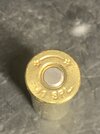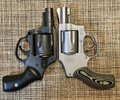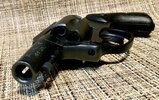You are using an out of date browser. It may not display this or other websites correctly.
You should upgrade or use an alternative browser.
You should upgrade or use an alternative browser.
What's Special about the 44 Special.
- Thread starter NorthBorder
- Start date
horsemen61
Member
- Joined
- Oct 20, 2011
- Messages
- 6,755
I liked my Model 69 for it’s size yes it was built as a mag but for me it shot way more specials
Miami_JBT
Member
Yeah, it says that their marketing department wasn't on the ball. Bird's head grips are not a modern invention. They did bird's head grips on other guns.Not Craig, but…
The fact that Colts never offered the birdshead grip on the SAA might tell you something.
Kevin
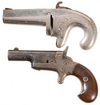
Colt did do a variation of the bird's head grip on the Lightning and Thunderer.
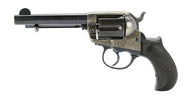
Some folks back in the day did install those grip frames on 1873 Single Action Army models via their local gunsmiths. Heck, some folks back then even had Colt 1860 Army frames installed on 1873 Single Action Army revolvers.
Here's a lettered Colt 1873 Single Action Army made in 1903 with a 1860 Army grip frame installed.
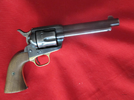
Just like today, companies make stuff and people modify 'em. You don't see GLOCK doing a bunch of stuff to their guns, but there is an entire industry built around modifying GLOCKs today. Gunsmiths did the same back then too.
As for how shooting a bird's head feels. I have two Rugers. An original large frame Vaquero in .45 Colt and a New Model Vaquero in .45 ACP. The bird's head grip makes them easier to conceal carry since both are 3.5" guns. Recoil wise, there is not a problem. Controllable and comfortable to shoot, even with the "Ruger Only Loads" in the large frame Vaquero.
Yeah, it says that their marketing department wasn't on the ball…
Since they were selling every revolver they were producing, the marketing department, if there was one, did not have to do anything.
Kevin
Stumbled into 44 specials when S&W was making the 696, which offered standard/easily controllable 45 acp power in a L frame. At the time they were not very popular and relatively inexpensive. Also thoroughly enjoy the S&W 45 acp revolvers with 45 AR brass.I'm pretty open to many calibers, but the .44 doesn't do it for me. The only time I've thought about getting .44 is for a 5 shot Magnum either the Taurus or the S&W Combat Magnum.
Between a .45 ACP revolver and a .44 Special, I'd rather have the .45. If someone would make a 5 shot .45 ACP wheelgun that's not Charter, I'd buy one, the cost of ammo and the amount free brass at the range make it a better choice than .44
Miami_JBT
Member
The most common gun carried back then were not 1873s or 1877s. It was small break-tops, specifically Smith & Wesson made guns/ Big Blue sold over a million top-breaks in .32 S&W and .38 S&W alone. That isn't counting all the clones like Iver Johnson, Hopkins & Allen, and Harrington & Richardson.Since they were selling every revolver they were producing, the marketing department, if there was one, did not have to do anything.
Kevin
Less than 360,000 full size Colt 1873s were made between its introduction to the end of its first production run in 1940. Many sitting on Colt's shelves as time move forward since the 1873 was not as advanced as other designs like the S&W Number 3 and competing double action designs from Europe. Colt even tried to sideline the 1873 with the 1877 and 1878 design and when that failed, they went back to the drawing board and eventually came up with the 1892 with the swing-out cylinder.
The Colt 1873 engrained itself into American myth due to Hollywood and the fact that the guns were cheap as surplus pieces when Hollywood started. But honestly, and I say this as a 1873 fan. The gun was pretty much outdated soon after it hit the market. The gun did not sell well overseas nor did it do well on the civilian market when it was new due to its size, cost, and single action only design.
The American consumer wanted compact concealable firearms, just like today's market.
After WWII, due to TV showing westerns (which for the studios were cheap to produce), you had competing companies start production of the 1873 clones, all while Colt didn't. That says something about Colt.
Colt is America's HK. A company that rests on its laurels and constantly survives due to government contracts, not civilian sales.
Thats why its known for taking down bears.Let's me shoot my .44mag at the indoor range where .44 mag is not allowed...Nice round for paper punching is all I use it for...
Driftwood Johnson
Member
Well, here is a fly in the ointment. There is nothing special about 44 Special. It was just a marketing term, much like 38 Special or 32 Winchester Special. But the revolvers that fired it are special.
Smith and Wesson had developed the 38 Special, or 38 Smith and Wesson Special as they preferred to call it, in 1899 if memory serves, for their first 38 caliber Military and Police revolver, the 38 Military and Police 1st Model, also known as the Model of 1899 Army-Navy revolver. When first developed, the 38 Special was loaded with Black Powder, which is why the case is so big, and why it looks so empty when loaded with Smokeless powder.
Here is a Model of 1899, easily recognized because it lacks an underbarrel latch in front of the ejector rod.

In 1908 S&W introduced the 44 Hand Ejector, 1st Model, also known as the New Century, but affectionately know as the Triple Lock, because of the extra latching mechanism. The 44 Special cartridge was introduced with this model. I have read various opinions that the cartridge was originally loaded with Black Powder, not Smokeless, but have never gotten to the bottom of that. This Triple Lock is a very early one, Roy Jinks told me it actually shipped in 1907, not 1908. Note the caliber marking on the barrel only says 44 S&W CTG, not the more common later marking of 44 S&W SPECIAL CTG. Roy said they probably had not come up with the 44 S&W SPECIAL CTG stamp yet when this one shipped.

The parent case to the new 44 Special was the old 44 Russian. Left to right in this photo the cartridges are 44 Magnum, 44 Special, 44 Russian, 44-40 and 38-40. The 44 Special was just a little bit longer then the 44 Russian. Sorry, I don't recall exactly how much longer. I have read that the ballistics of the new cartridge merely duplicated the 246 grain 755 f/s ballistics of the older 44 Russian cartridge, but it did retain the 44 Russian's reputation for accuracy.

While I'm at it here is a photo of the third latch of a Triple Lock.

And here is the hardened insert mounted on the yoke that received the third latch.

Here is an unusual Triple Lock, a Target Model with tall front sight and adjustable rear sight.

A nickle plated Triple Lock.

In 1915 Smith and Wesson deleted the third latch with the 44 Hand Ejector 2nd Model.

This is a 44 Hand Ejecctor 3rd Model, also known as the Wolf & Klar Model, for the distributor that requested S&W put a large under barrel shroud under the barrel. This particular example was carried by an officer during WWII. It was refinished and nickel plated at some point, S&W never nickle plated hammers or triggers.

A 44 Hand Ejector 4th Model.

Like I said, there is nothing 'special' about the 44 Special cartridge, but a lot of the revolvers chambered for it are very special.
I see there are still problems posting some of my photos.
Smith and Wesson had developed the 38 Special, or 38 Smith and Wesson Special as they preferred to call it, in 1899 if memory serves, for their first 38 caliber Military and Police revolver, the 38 Military and Police 1st Model, also known as the Model of 1899 Army-Navy revolver. When first developed, the 38 Special was loaded with Black Powder, which is why the case is so big, and why it looks so empty when loaded with Smokeless powder.
Here is a Model of 1899, easily recognized because it lacks an underbarrel latch in front of the ejector rod.

In 1908 S&W introduced the 44 Hand Ejector, 1st Model, also known as the New Century, but affectionately know as the Triple Lock, because of the extra latching mechanism. The 44 Special cartridge was introduced with this model. I have read various opinions that the cartridge was originally loaded with Black Powder, not Smokeless, but have never gotten to the bottom of that. This Triple Lock is a very early one, Roy Jinks told me it actually shipped in 1907, not 1908. Note the caliber marking on the barrel only says 44 S&W CTG, not the more common later marking of 44 S&W SPECIAL CTG. Roy said they probably had not come up with the 44 S&W SPECIAL CTG stamp yet when this one shipped.

The parent case to the new 44 Special was the old 44 Russian. Left to right in this photo the cartridges are 44 Magnum, 44 Special, 44 Russian, 44-40 and 38-40. The 44 Special was just a little bit longer then the 44 Russian. Sorry, I don't recall exactly how much longer. I have read that the ballistics of the new cartridge merely duplicated the 246 grain 755 f/s ballistics of the older 44 Russian cartridge, but it did retain the 44 Russian's reputation for accuracy.

While I'm at it here is a photo of the third latch of a Triple Lock.

And here is the hardened insert mounted on the yoke that received the third latch.

Here is an unusual Triple Lock, a Target Model with tall front sight and adjustable rear sight.

A nickle plated Triple Lock.
In 1915 Smith and Wesson deleted the third latch with the 44 Hand Ejector 2nd Model.

This is a 44 Hand Ejecctor 3rd Model, also known as the Wolf & Klar Model, for the distributor that requested S&W put a large under barrel shroud under the barrel. This particular example was carried by an officer during WWII. It was refinished and nickel plated at some point, S&W never nickle plated hammers or triggers.

A 44 Hand Ejector 4th Model.

Like I said, there is nothing 'special' about the 44 Special cartridge, but a lot of the revolvers chambered for it are very special.
I see there are still problems posting some of my photos.
Last edited:
unspellable
Member
1908 was well into the smokeless era, I think the special was loaded with both, the BP version for the diehards. The 44 Special as loaded with black powder had 1 grain more than the Russian, so it had a slight edge in performance.
So does a 10mm.Thats why its known for taking down bears.
CraigC
Sixgun Nut
I think there's a lot special about the .44Special and the guns that chamber it. 
Bazoo
Member
I love the 44 Special, and I also love the 44 Magnum. They compliment each other perfectly. What makes the 44 Special over other cartridges? It's balanced. The diameter, the length, it all looks right, plus the power for the size of cartridge is all balanced. Does it make it perform any better than anything else? I guess that depends on who uses it and what they put into load development. It's a joy to reload for.
Carl N. Brown
Member
OP: What's Special about .44 Special?
The same thing Special about .38 Special!
They were both developed by Smith & Wesson.
.38 Special was a lengthening of a parent cartridge, the .38 Long Colt.
.44 Special was a lengthening of a parent cartridge, the .44 Russian.
Smith & Wesson did not want to call their new cartridges .38 Long Colt Long or .44 Russian Long or stamp their pistol barrels with "Colt" or "Russian" in the cartrdge names.
So Smith & Wesson called them S&W Specials.
Their parents were proud of them even if they were sorta adopted.
The same thing Special about .38 Special!
They were both developed by Smith & Wesson.
.38 Special was a lengthening of a parent cartridge, the .38 Long Colt.
.44 Special was a lengthening of a parent cartridge, the .44 Russian.
Smith & Wesson did not want to call their new cartridges .38 Long Colt Long or .44 Russian Long or stamp their pistol barrels with "Colt" or "Russian" in the cartrdge names.
So Smith & Wesson called them S&W Specials.
Their parents were proud of them even if they were sorta adopted.
Oldschool shooter
Member
My wife shoots 2 of my revolvers extremely well. One is a 1917 in 45acp. The other is my model 29 shooting 44 Specials. Recoil in the large frame revolvers is very tame.
Riomouse911
Member
Mark_Mark
Member
- Joined
- Jan 9, 2021
- Messages
- 17,931
I didn’t even know they did a .41 Special! bet that is a FUN shooterTrue. But these are pretty nice shooters!
View attachment 1192521
Now if I could just get a 6-shot L frame .41 Special
Stay safe.
Riomouse911
Member
One of John Taffin’s favorites.I didn’t even know they did a .41 Special! bet that is a FUN shooter

Its a roll-your-own proposition, but its worth it.
Stay safe.
I don't have a dedicated .44 Special anymore, but it's a very good all around cartridge. It can be easy to shoot, pokes big holes and can be loaded up warm enough to take care of most situations you would use a 44 Mag for. I can't say anything bad about the 44 Special, the only reason I don't have one is because it's easier for me to just keep 44 Mag brass around and truthfully, you can load the 44 Mag down and just use that as your "44 Special".
.308 Norma
Member
I can and do just that - a lot. "Truthfully" though, both of my 44 Mag revolvers are larger guns than the 44 Special revolver I'll eventually find and buy someday (if I live long enough). Loading a 44 Mag revolver "down" doesn't make the gun itself any smaller.truthfully, you can load the 44 Mag down and just use that as your "44 Special".
TTv2
Member
- Joined
- Mar 31, 2016
- Messages
- 4,990
I worked with a guy about 10 years ago and he said the only time he found the .44 Mag comfortable to shoot was when he was reloading it and basically loading it to .44 Special territory. When I said I'm not much into the .44 caliber as a whole, I'm far less interested in the .44 Special than the Magnum because when I look at the FEW revolvers available in the chambering, other than the Charter Bulldog, they all weigh the same as the 5 shot .44 Magnum revolvers that S&W and Taurus make.
What's the point of buying a weaker and less popular caliber when a magnum that is the same size and weight is available?
Now, those who read my posts in the .32 H&R thread will be thinking hypocrite, but there's a difference between the .32 H&R and .327 Magnum as one can be put in ultralight Aluminum frames while the other can't and the recoil with the .32 H&R is still very low in an ultralight. The same cannot be said of .44 Spl in something like the Charter Arms Bulldog where cutting a full pound off the weight is great for carrying, but shooting will not be pleasant and all I've read about them is they get loose quickly, not too mention Charter's current major QC woes.
I would rather buy the .44 Magnum and load it with downloaded .44 Mag ammo but still have the ability to use full power magnums. The .44 Special can never give me that option.
What's the point of buying a weaker and less popular caliber when a magnum that is the same size and weight is available?
Now, those who read my posts in the .32 H&R thread will be thinking hypocrite, but there's a difference between the .32 H&R and .327 Magnum as one can be put in ultralight Aluminum frames while the other can't and the recoil with the .32 H&R is still very low in an ultralight. The same cannot be said of .44 Spl in something like the Charter Arms Bulldog where cutting a full pound off the weight is great for carrying, but shooting will not be pleasant and all I've read about them is they get loose quickly, not too mention Charter's current major QC woes.
I would rather buy the .44 Magnum and load it with downloaded .44 Mag ammo but still have the ability to use full power magnums. The .44 Special can never give me that option.
CraigC
Sixgun Nut
99% of the time, one doesn't 'need' that option. For example, the Ruger mid-frame I posted before weighs 37oz. It's basically the size of a Colt SAA with adjustable sights. A Super Blackhawk is significantly heavier and bulkier. To what end? As a field sidearm, how much horsepower do you really need? This idea that the critics of the .44Spl have that they're missing out on something, it just isn't true.I worked with a guy about 10 years ago and he said the only time he found the .44 Mag comfortable to shoot was when he was reloading it and basically loading it to .44 Special territory. When I said I'm not much into the .44 caliber as a whole, I'm far less interested in the .44 Special than the Magnum because when I look at the FEW revolvers available in the chambering, other than the Charter Bulldog, they all weigh the same as the 5 shot .44 Magnum revolvers that S&W and Taurus make.
What's the point of buying a weaker and less popular caliber when a magnum that is the same size and weight is available?
Now, those who read my posts in the .32 H&R thread will be thinking hypocrite, but there's a difference between the .32 H&R and .327 Magnum as one can be put in ultralight Aluminum frames while the other can't and the recoil with the .32 H&R is still very low in an ultralight. The same cannot be said of .44 Spl in something like the Charter Arms Bulldog where cutting a full pound off the weight is great for carrying, but shooting will not be pleasant and all I've read about them is they get loose quickly, not too mention Charter's current major QC woes.
I would rather buy the .44 Magnum and load it with downloaded .44 Mag ammo but still have the ability to use full power magnums. The .44 Special can never give me that option.
Further, same also applies to DA's. Sure, you can get a S&W 69 but I really don't want to shoot full power .44Mag out of such a light sixgun. I don't and imagine most others don't either. A 240gr at 1200fps like some of the milquetoast loads available today isn't a true .44Mag load. It's equivalent to the Keith Special load, about 10,000psi below .44Mag. Increase that bullet weight by over 100gr and that is a .44Mag load. For such loads, I want a bigger, more comfortable to shoot sixgun. Like this Bisley, half a pound heavier than the flat-top.

It's truly sad that so many talk themselves out of a good .44 Special. Because you'll never truly know.
TTv2
Member
- Joined
- Mar 31, 2016
- Messages
- 4,990
If I really wanted a single action big bore in a non-magnum, I'd get a .45 Colt, probably one with a conversion cylinder for .45 ACP since that's so nice to have. Now, I hear that .44 Special is more accurate than .45 Colt and I will say I do notice .45 Schofield shoots tighter groups than .45 Colt does, so I doubt that .44 Spl would be significantly more accurate than .45 Schofield.99% of the time, one doesn't 'need' that option. For example, the Ruger mid-frame I posted before weighs 37oz. It's basically the size of a Colt SAA with adjustable sights. A Super Blackhawk is significantly heavier and bulkier. To what end? As a field sidearm, how much horsepower do you really need? This idea that the critics of the .44Spl have that they're missing out on something, it just isn't true.
Further, same also applies to DA's. Sure, you can get a S&W 69 but I really don't want to shoot full power .44Mag out of such a light sixgun. I don't and imagine most others don't either. A 240gr at 1200fps like some of the milquetoast loads available today isn't a true .44Mag load. It's equivalent to the Keith Special load, about 10,000psi below .44Mag. Increase that bullet weight by over 100gr and that is a .44Mag load. For such loads, I want a bigger, more comfortable to shoot sixgun. Like this Bisley, half a pound heavier than the flat-top.

It's truly sad that so many talk themselves out of a good .44 Special. Because you'll never truly know.
If I want a double action big bore, given that there's not many .45 Colt's with the strength other than the Redhawk, .44 Mag becomes the good option because am I going to shoot ONLY full power .44 Mag from it? No, of course not, but I'm always going to be able to shoot more powerful than .44 Special can AND do it safely and not add unnecessary wear and tear on the gun.
I do this in most of my revolvers, the only time I'll go with the lower power non-magnums is when I'm looking at a snub because I'm looking to get the lighter alloy frame.
Tallball
Member
- Joined
- Oct 2, 2014
- Messages
- 7,805
@TTv2 "The same cannot be said of .44 Spl in something like the Charter Arms Bulldog where cutting a full pound off the weight is great for carrying, but shooting will not be pleasant and all..."
FWIW, I have a Bulldog in 44 special and a Pitbull in 45acp. The recoil feels different than shooting 38 in an aluminum-framed snub, but not worse. My hand would feel about the same after shooting a 50-round box of 44's through my Bulldog or a box of 38's through my 642. The only thing that the 44 would hurt would be my wallet.
FWIW, I have a Bulldog in 44 special and a Pitbull in 45acp. The recoil feels different than shooting 38 in an aluminum-framed snub, but not worse. My hand would feel about the same after shooting a 50-round box of 44's through my Bulldog or a box of 38's through my 642. The only thing that the 44 would hurt would be my wallet.
Similar threads
- Replies
- 78
- Views
- 6K
- Replies
- 26
- Views
- 6K
- Replies
- 26
- Views
- 3K
- Replies
- 38
- Views
- 3K
- Replies
- 28
- Views
- 2K


